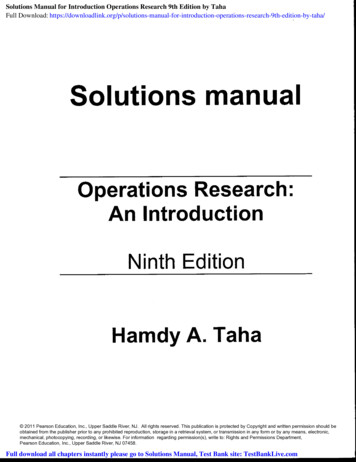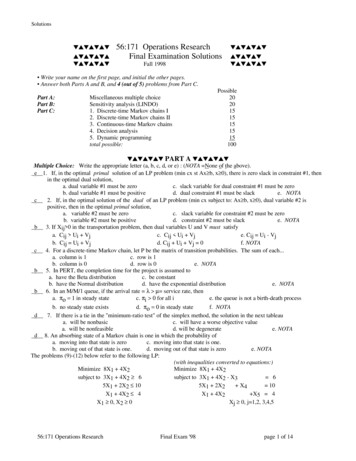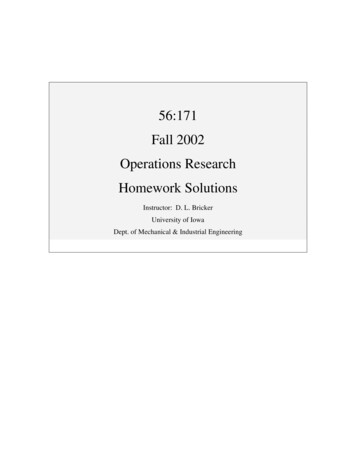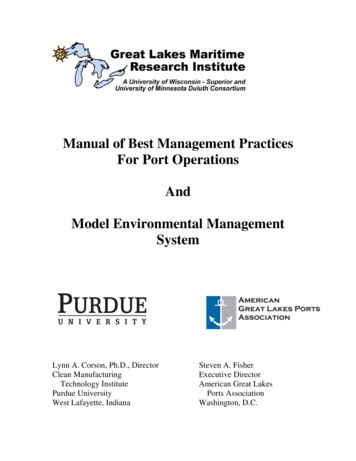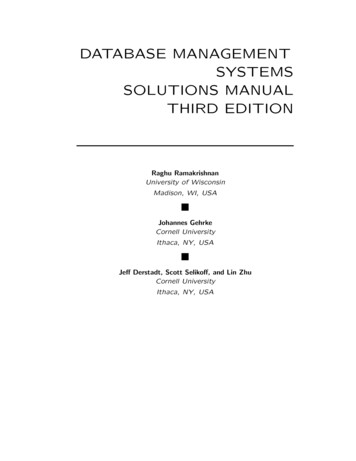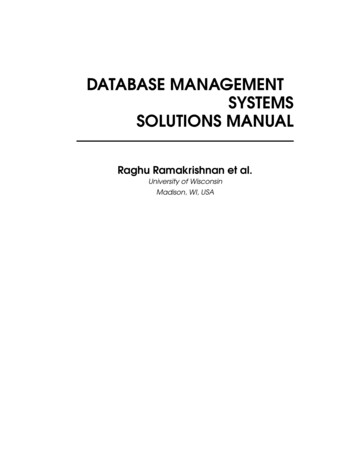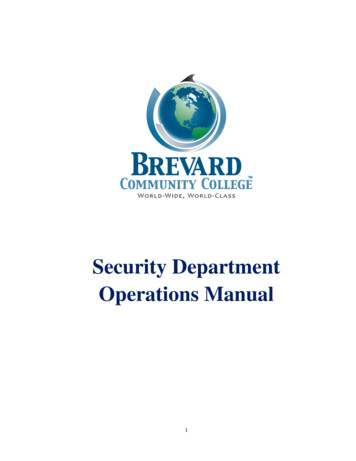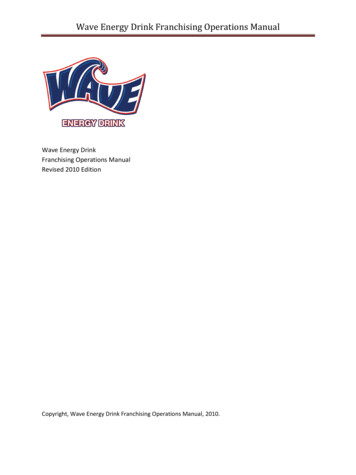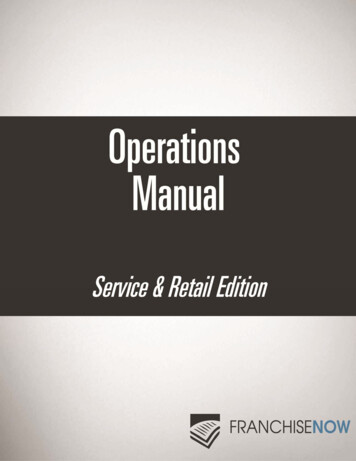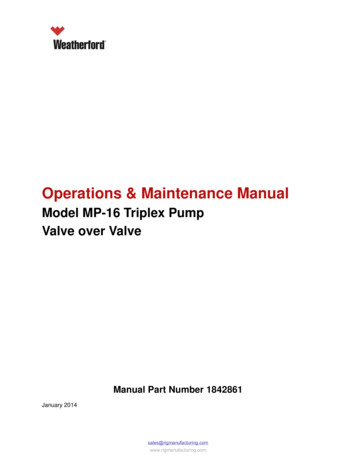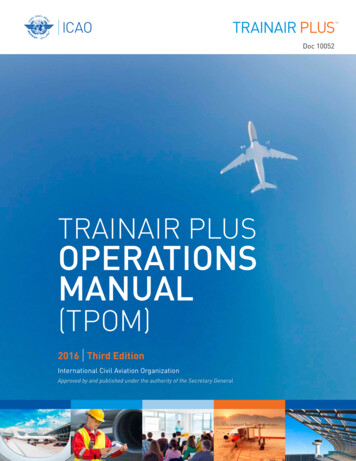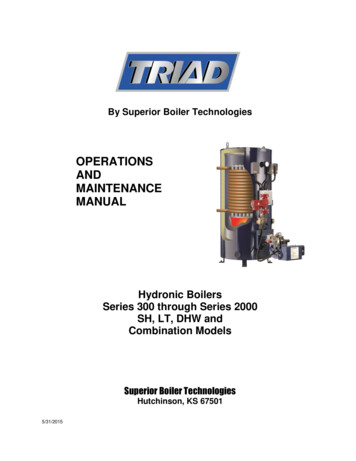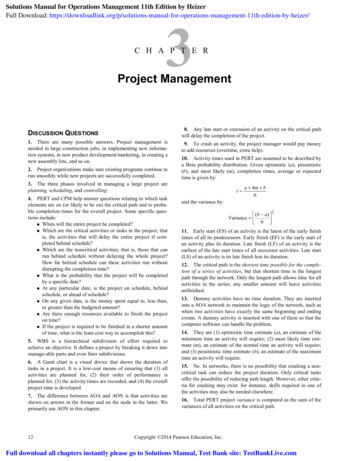
Transcription
Solutions Manual for Operations Management 11th Edition by HeizerFull Download: erations-management-11th-edition-by-heizer/3C H A P T E RProject Management8. Any late start or extension of an activity on the critical pathwill delay the completion of the project.DISCUSSION QUESTIONS1. There are many possible answers. Project management isneeded in large construction jobs, in implementing new information systems, in new product development/marketing, in creating anew assembly line, and so on.2. Project organizations make sure existing programs continue torun smoothly while new projects are successfully completed.9. To crash an activity, the project manager would pay moneyto add resources (overtime, extra help).10. Activity times used in PERT are assumed to be described bya Beta probability distribution. Given optimistic (a), pessimistic(b), and most likely (m), completion times, average or expectedtime is given by:3. The three phases involved in managing a large project areplanning, scheduling, and controlling.4. PERT and CPM help answer questions relating to which taskelements are on (or likely to be on) the critical path and to probable completion times for the overall project. Some specific questions include: When will the entire project be completed? Which are the critical activities or tasks in the project; thatis, the activities that will delay the entire project if completed behind schedule? Which are the noncritical activities; that is, those that canrun behind schedule without delaying the whole project?How far behind schedule can these activities run withoutdisrupting the completion time? What is the probability that the project will be completedby a specific date? At any particular date, is the project on schedule, behindschedule, or ahead of schedule? On any given date, is the money spent equal to, less than,or greater than the budgeted amount? Are there enough resources available to finish the projecton time? If the project is required to be finished in a shorter amountof time, what is the least-cost way to accomplish this?5. WBS is a hierarchical subdivision of effort required toachieve an objective. It defines a project by breaking it down intomanage-able parts and even finer subdivisions.6. A Gantt chart is a visual device that shows the duration oftasks in a project. It is a low-cost means of ensuring that (1) allactivities are planned for, (2) their order of performance isplanned for, (3) the activity times are recorded, and (4) the overallproject time is developed.7. The difference between AOA and AON is that activities areshown on arrows in the former and on the node in the latter. Weprimarily use AON in this chapter.12t a 4m b6and the variance by: (b a ) Variance 6 211. Early start (ES) of an activity is the latest of the early finishtimes of all its predecessors. Early finish (EF) is the early start ofan activity plus its duration. Late finish (LF) of an activity is theearliest of the late start times of all successor activities. Late start(LS) of an activity is its late finish less its duration.12. The critical path is the shortest time possible for the completion of a series of activities, but that shortest time is the longestpath through the network. Only the longest path allows time for allactivities in the series; any smaller amount will leave activitiesunfinished.13. Dummy activities have no time duration. They are insertedinto a AOA network to maintain the logic of the network, such aswhen two activities have exactly the same beginning and endingevents. A dummy activity is inserted with one of them so that thecomputer software can handle the problem.14. They are (1) optimistic time estimate (a), an estimate of theminimum time an activity will require; (2) most likely time estimate (m), an estimate of the normal time an activity will require;and (3) pessimistic time estimate (b), an estimate of the maximumtime an activity will require.15. No. In networks, there is no possibility that crashing a noncritical task can reduce the project duration. Only critical tasksoffer the possibility of reducing path length. However, other criteria for crashing may exist: for instance, skills required in one ofthe activities may also be needed elsewhere.16. Total PERT project variance is computed as the sum of thevariances of all activities on the critical path.Copyright 2014 Pearson Education, Inc.Full download all chapters instantly please go to Solutions Manual, Test Bank site: TestBankLive.com
CHAPTER 3PROJECT M ANAGEM ENT1317. Slack: the amount of time an activity can be delayed and notaffect the overall completion time of the whole project. Slack canbe determined by finding the difference between the earliest starttime and the latest start time, or the earliest finish time and the latest finish time for a given activity.In every case, quality project management means opencommunication, realistic timetables, good staff, and use ofsoftware like MS Project to build and maintain a schedule.Bidding on a contract with a schedule that is not feasible may beunethical as well as poor business.18. If there are a sufficient number of tasks along the criticalpath, we can assume that project completion time is described by anormal probability distribution with mean equal to the sum of theexpected times of all activities on the critical path and varianceequal to the sum of the variances of all activities on the criticalpath.ACTIVE MODEL EXERCISE*ACTIVE MODEL 3.1: Gantt ChartThe fundamental assumption required is that the number ofactivities on the critical path is large enough that the mean of thesum of the Beta distributions is distributed approximately as thenormal distribution.1. Both A and H are critical activities. Describe the differencebetween what happens on the graph when you increase A vs.increasing H.When you increase H, it is the only task to change on thechart. However, when you increase A then all critical tasksmove to the right and the slack for the noncritical tasksincreases.19. Widely used project management software include’s MSProject, MacProject, Primavera, Mind View, HP Project, and FastTrack.2. Activity F is not critical. By how many weeks can you increase activity F until it becomes critical?6 weeksETHICAL DILEMMA3. Activity B is not critical. By how many weeks can you increase activity B until it becomes critical? What happens when Bbecomes critical?1 week. Activity D also becomes critical.Large projects with time/cost overruns are not uncommonsituations in the world of project management. Why do MISprojects commonly sport 200–300% cost overruns and completiontimes twice those projected? Why do massive constructionprojects run so late and so overbudget?Students are expected to read about such projects and comeup with explanations, especially related to ethics. In the case ofMIS projects, long software development tasks are almostdoomed to failure because of the changes in technology and staffthat take place. It’s a necessity to break large projects down intosmaller 3- to 6-month modules or pieces that are self-contained.This protects the organization from a total loss should the massiveproject never be completed.4. What happens when you increase B by 1 more week after itbecomes critical?Activities A, C, and E become noncritical, and the projecttakes 1 additional week.5. Suppose that building codes may change and, as a result,activity B would have to be completed before activity C could bestarted. How would this affect the project?Activity B becomes critical, and the project takes 1additional week.*Active Model 3.1 appears on our Web sites, atwww.pearsonhighered.com/heizer and www.myomlab.com.Copyright 2014 Pearson Education, Inc.
14CHAPTER 3 P R O J E C T M A N A G E M E N TEND-OF-CHAPTER PROBLEMS3.1 Some possible Level 3[(a)] and Level 4[(b)] activities for the house appear for each Level 2 activity below.Copyright 2014 Pearson Education, Inc.
PROJECT M ANAGEM ENTCHAPTER 33.2Here are some detailed activities to add to Day’s WBS:*153.6 (a)1.11 Set initial goals for fundraising1.12 Set strategy including identifying sources andsolicitation1.13 Raise the funds1.21 Identify voters’ concerns1.22 Analyze competitor’s voting record1.23 Establish positions on issues1.31 Hire campaign manager and political advisor1.32 Get volunteers(b) Critical path is B–D–E–G1.33 Hire a staffActivity1.34 Hire media consultants1.41 Identify filing deadlines1.42 File for candidacy1.51 Train staff for audit planningStudents could make many other choices.*Source: Modified from an example found in M. Hanna and W. Newman,Operations Management: Prentice Hall, Upper Saddle River,NJ (2001): p. 1301151512181551215181826Slack Critical13011001103.33.7 (a)Critical path is A–C–F–H. Time 21 days.This is an AON network.3.4(b, c) There are four paths:PathTime B–E–G19.524.928.7 (critical)15.7Critical path is A–C–F–G–I. Time 21 days.This is an AOA network.3.5 The paths through this network are J–L–O, J–M–P,J–M–N–O, K–P, and K–N–O. Their path durations are 23, 18, 22,13, and 17. J–L–O is the critical path; its duration is 23.Copyright 2014 Pearson Education, Inc.NoYesNoYesYesNoYes
CHAPTER 3 P R O J E C T M A N A G E M E N T163.83.12(a)(b, 009409040ABCDEFGHI(a) AON network:Activities on the critical path: A, B, E, G, IProject completion time 343.13(b) AOA 191941181920223.14Note: Activity times are shown as an aid for Problem 3.11. They are notrequired in the solution to Problem 3.10.t a 4m b6σ 15321813.1718.1719b .251.000.111.001.78(b, 12120260101NoYesNoNoYesNoYesNoThe critical path is given for activities B, E, G.Total project completion time is 21 0.002.176.0011.0016.337.33Copyright 2014 Pearson Education, 20.0029.00LFSlack Critical13.00 7.17No9.005.33No2.000.00Yes9.000.00Yes13.00 0.00Yes23.00 0.00Yes18.00 2.83No29.00 0.00Yes29.00 2.83No36.33 18.00No36.33 0.00Yes
CHAPTER 3The critical path is given by activities C, D, E, F, H, K. Averageproject completion time is 36.33 days.(d)PROJECT M ANAGEM ENT173.17Expected completion time for the project is 36.33days. Project variance Sum of variances of activities on critical path 0.11 0.11 0.44 1.78 1.00 1.78 5.22. Standard deviation 2.28(a) Estimated (expected) time for C [8 (4 12) 16]/6 72/6 12 weeks40 36.33 P (t 40) P z P [ z 1.61] 0.9462.28 16 (16 8) (b) Variance for C is 9 1.78 6 2(c) Critical path is A–C–F–H–J–K3.15(d) Time on critical path 7.67 12 9.67 2 6.67 2.17 40.18 weeks (rounded)(a) AON diagram of the project:(e) Variance on critical path 1 1.78 5.44 0 1.78 0.03 10.0336 40.18(f) Z –1.32, which is about 9.6% chance3.17(.096 probability) of completing project before week 36.(b)The critical path, listing all critical activities inchronological order:A B E FA C F(c)Note that based on possible rounding in part (d)—where time on critical path could be 40.3—the probability can be as low as 8.7%. So a student answerbetween 8.7% and 9.6% is valid.1 1 2 2 6 ( not CP )1 4 2 7. This is the CP.The project duration (in weeks):7 (This is the length of CP.)(d)The slack (in weeks) associated with any and all noncritical paths through the project: Look at the pathsthat aren’t critical—only 1 here—so from above:A B E F3.167 – 6 1 week slack.Helps to modify the AON with the lowest costs to crash:1. CP is A C F; C is cheapest to crash, so take it to3 wks at 200 (and 200 250)2. Now both paths through are critical. We would need toshorten A or F, or shorten C and either B/E. This is notworth it, so we would not bother to crash any further.Copyright 2014 Pearson Education, Inc.
CHAPTER 3 P R O J E C T M A N A G E M E N T18Summary table for Problem 3.17 ate 6000.33001.330.17Figure for Problem 3.203.18Critical path C–E at 12 days.ActivityABCDE(d)Daily Crash Costs 10050100150200Maximum Crash1 day2 days1 day2 days3 days3.21 (a) Activity Crash C by 1 day ( 100) to 11 days total Now crash E by 1 day ( 200) and A by 1 day ( 100) to 10 daystotal. Now crash E by 2 days ( 400) and D by 2 days ( 300) to 8 daystotal. Total additional cost to crash 4 days 1,100.3.19 Crash costs per unit time are 600 for A, 900 for B, and 1,000 for C. (a) A offers the cheapest path to a single day reduction. (b) A cannot supply a second reduction, so the next bestchoice is B, which adds 900. (c) The total for both days is 1,500.(a) Project completion time 16 (Activities A–D–G)ActivityABCDEFGNorm. Time–Crash TimeCrash –Normal /time1104312 60060003003001,200600 600600—751001,200300(b)Total cost 12,300.(c)Crash D 1 week at an additional cost of 75.CrashDGAEABCDCost4211 3006006001007 weeksTo crash by 4 days, from 12 days to 8 days:3.20Activity .111(b) Critical path is A– C with mean (te) co
Operations Management: Prentice Hall, Upper Saddle River, NJ (2001): p. 722. 3.3 3.4 3.6 (a) Activity Time ES EF LS LF Slack Critical A 2 0 2 13 15 13 No B 5 0 5 0 5 0 Yes C 1 0 1 11 12 11 No D 10 5 15 5 15 0 Yes E 3 15 18 15 18 0 Yes F 6 1 7 12 18 11 No G 8 18 26 18 26 0 Yes 3.7 (a)
